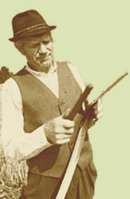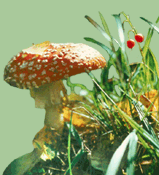Flying Squirrel, a rarity of hidden lifestyle
Uudo Timms cover story features one of the rarest rodents of our old forests the Flying Squirrel. The future of this nearly invisible animal is largely dependent on human activity. The flying squirrel is also the symbol species of the Estonian Fund for Nature. The article gives a detailed overview of the animals biology, distribution and behavior. The biggest habitat of flying squirrels in Estonia is located in Virumaa. Options for its protection are discussed as well. The main danger for flying squirrel is forest felling, followed by destruction of habitats. The article includes comparisons of distribution and research carried out in Finland.
Saaremaa provided the world a new orchid species
Tarmo Pikner introduces the new orchid found and first described by himself. This orchid, Dactylorhiza osiliensis Pikner, is as unique as the Saaremaa Yellow Rattle on the world scale. The author explains how the species was determined and which analyses were made. Colourful close-up photographs help to understand the characteristics of the species. Interestingly enough, the author and finder of the species is not a botanist, but a hobby-researcher.
Estonian Nature enquires
Jüri-Ott Salm discusses the future plans of the 15-year old Estonian Fund for Nature.
Kristel Toom describes the activities during the rescue and rehabilitation works at the oil-spill crises center.
Urban springs in Tallinn
Hella Kink and Maire-Liis Hääl take a look at important Natura 2000 habitats found in Löwenruh Park, Lepasalu and the foot of the Klint, in Tallinn. The current status and hydrogeological features of 5 springs are covered. Necessary protection requirements are proposed as well, since the urban location of these springs causes a constant threat through human activity, especially transport and partial lack of sewage systems at Nõmme.
Essay: Fire is alive by Hendrik Relve
Rabivere landscape protection area
Roland Müür takes us to ancient Southern Harjumaa, to visit an exceptional bog at a karst area between Hageri and Hagudi. In addition to its unique location at karst area, the bog is also important historically: in 1936, a petrified corpse of a woman was found there by local people. The bog does not have a board trail yet.
Interview: On the edge of the water
Ann Marvet has interviewed Nikolai Laanetu, zoologist and ecologist.
On mapping the control line (border) at Petserimaa in 1949
Ilja Kala recalls his journey to observe the new control line in nature. In September 1949, the young geography student Ilja Kala sat on his bike and started to question the local people about the location of the borderline. The trip lasted for 4 days, during which the new line was mapped. The article is supplemented with authors pictures of life in Petserimaa in 1949, and commented by geographer Ott Kurs.
Other kind of winter
Sven Zaèek convinces the reader of the charms of winter. The seemingly cold and silent season can offer a wide range of experiences. The best way to observe birds in winter is to put up a feeding house. This winter the author has observed Waxwings, and then turned to woods and rivers to meet the Eurasian Dipper and Hawk-Owl. Photographs appended to the article confirm these personal encounters.
White blueberries and white Fireweed
Piret Raudsepp describes the complicated biochemical reasons behind the genesis of white berries or blossoms. Classification and biosynthesis of certain flavonoids is described in text and graphs. The most probable reason for the loss of pigment is a disturbance of a gene participating in the biosynthesis of flavonoids.
Willow trees are spread unevenly in Estonia
Toomas Kukk ja Tiiu Kull look for the most willow-rich part of Estonia, the Willow-Estonia: the surroundings of East- and South-Estonian large waterbodies. Most of willow species feel well in Estonia; only a few species show a decreasing trend.
Geologists had their first autumn school
Ethel Uibopuu and Kadri Sohar share their impressions of a newly founded event, the autumnal gathering of Estonian Earth scientists - Schola geologica I. The school focused on the concept of science in geology and conjoined also many scientists outside of the geological science.
| 

![[IN ENGLISH]](images/gb.gif)





